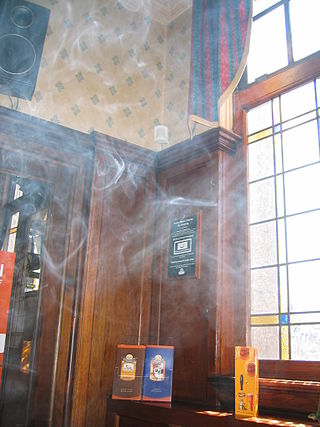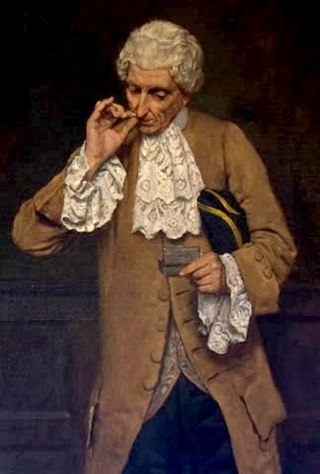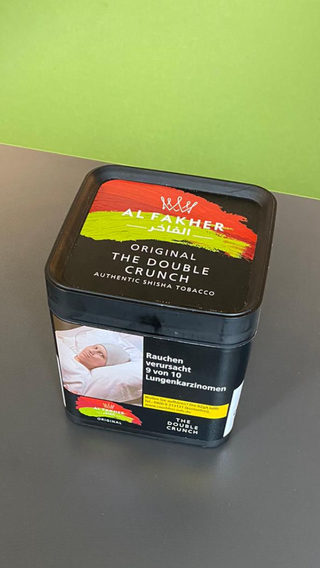
A cigarette is a narrow cylinder containing a combustible material, typically tobacco, that is rolled into thin paper for smoking. The cigarette is ignited at one end, causing it to smolder; the resulting smoke is orally inhaled via the opposite end. Cigarette smoking is the most common method of tobacco consumption. The term cigarette, as commonly used, refers to a tobacco cigarette, but the word is sometimes used to refer to other substances, such as a cannabis cigarette or a herbal cigarette. A cigarette is distinguished from a cigar by its usually smaller size, use of processed leaf, and paper wrapping, which is typically white.

Tobacco smoking is the practice of burning tobacco and ingesting the resulting smoke. The smoke may be inhaled, as is done with cigarettes, or simply released from the mouth, as is generally done with pipes and cigars. The practice is believed to have begun as early as 5000–3000 BC in Mesoamerica and South America. Tobacco was introduced to Eurasia in the late 17th century by European colonists, where it followed common trade routes. The practice encountered criticism from its first import into the Western world onwards but embedded itself in certain strata of a number of societies before becoming widespread upon the introduction of automated cigarette-rolling apparatus.

A hookah, shisha, or waterpipe is a single- or multi-stemmed instrument for heating or vaporizing and then smoking either tobacco, flavored tobacco, or sometimes cannabis, hashish and opium. The smoke is passed through a water basin—often glass-based—before inhalation.

Passive smoking is the inhalation of tobacco smoke, called passive smoke, secondhand smoke (SHS) or environmental tobacco smoke (ETS), by individuals other than the active smoker. It occurs when tobacco smoke diffuses into the surrounding atmosphere as an aerosol pollutant, which leads to its inhalation by nearby bystanders within the same environment. Exposure to secondhand tobacco smoke causes many of the same diseases caused by active smoking, although to a lower prevalence due to the reduced concentration of smoke that enters the airway.
Tar is the name for the resinous, combusted particulate matter made by the burning of tobacco and other plant material in the act of smoking. Tar is toxic and damages the smoker's lungs over time through various biochemical and mechanical processes. Tar also damages the mouth by rotting and blackening teeth, damaging gums, and desensitizing taste buds. Tar includes the majority of mutagenic and carcinogenic agents in tobacco smoke. Polycyclic aromatic hydrocarbons (PAH), for example, are genotoxic and epoxidative.

Tobacco products, especially when smoked or used orally, have negative effects on human health. Researchers have addressed concerns about these effects for a long time. They have focused primarily on cigarette smoking.

Smokeless tobacco is a tobacco product that is used by means other than smoking. Their use involves chewing, sniffing, or placing the product between gum and the cheek or lip. Smokeless tobacco products are produced in various forms, such as chewing tobacco, snuff, snus, and dissolvable tobacco products. Smokeless tobacco products typically contain over 3000 constituents. Smokeless tobacco is widely used in South Asia and this accounts for about 80% of global consumption, as per WHO data. All smokeless tobacco products contain nicotine and are therefore highly addictive. Quitting smokeless tobacco use is as challenging as smoking cessation.
Herbal cigarettes are cigarettes that usually do not contain any tobacco or nicotine, instead being composed of a mixture of various herbs and/or other plant material. However, Chinese herbal cigarettes contain tobacco and nicotine with herbs added, unlike European and North American herbal cigarettes which have tobacco and nicotine omitted. Like herbal smokeless tobacco, they are often used as a substitute for standard tobacco products. Herbal cigarettes are often advertised as a smoking cessation aid. They are also used in acting scenes by performers who are non-smokers, or where anti-smoking legislation prohibits the use of tobacco in public spaces. Herbal cigarettes can carry carcinogens.
Tobacco harm reduction (THR) is a public health strategy to lower the health risks to individuals and wider society associated with using tobacco products. It is an example of the concept of harm reduction, a strategy for dealing with the use of drugs. Tobacco smoking is widely acknowledged as a leading cause of illness and death, and reducing smoking is vital to public health.

An electronic cigarette (e-cigarette) or vape is a device that simulates tobacco smoking. It consists of an atomizer, a power source such as a battery, and a container such as a cartridge or tank. Instead of smoke, the user inhales vapor. As such, using an e-cigarette is often called "vaping". The atomizer is a heating element that vaporizes a liquid solution called e-liquid, which quickly cools into an aerosol of tiny droplets, vapor and air. The vapor mainly comprises propylene glycol and/or glycerin, usually with nicotine and flavoring. Its exact composition varies, and depends on several things including user behavior.

Smoking is a practice in which a substance is combusted and the resulting smoke is typically inhaled to be tasted and absorbed into the bloodstream of a person. Most commonly, the substance used is the dried leaves of the tobacco plant, which have been rolled with a small rectangle of paper into an elongated cylinder called a cigarette. Other forms of smoking include the use of a smoking pipe or a bong.
Dokha is a tobacco product, consisting of dried and finely shredded tobacco flakes mixed with herbs and spices. It originated in Iran during the 16th century. Unlike hookah tobacco, dokha is not cured with molasses. Users smoke the tobacco blend in small quantities using a pipe called a midwakh. Because the midwakh pipe is used almost exclusively for smoking dokha, the terms are often used interchangeably.

Flavored tobacco products — tobacco products with added flavorings — include types of cigarettes, cigarillos and cigars, hookahs and hookah tobacco, various types of smokeless tobacco, and more recently electronic cigarettes. Flavored tobacco products are especially popular with youth and have therefore become targets of regulation in several countries.

Muʽassel, or maassel, is a syrupy tobacco mix containing molasses, vegetable glycerol and various flavourings which is smoked in a hookah, a type of waterpipe. It is also known as "shisha".

Smoking in Syria is steadily increasing in popularity amongst the Syrian population, mainly in the forms of cigarettes or narghiles. In Syria, the General Organization of Tobacco manages the growth and exportation of tobacco products. Syrians collectively spend about $600 million per year on tobacco consumption. As of 2010, 20% of women and 60% of men smoke and 98% of the overall population is affected by passive smoking. Narghiles and cigarettes are the two main forms of tobacco consumption. Despite the assumption that smoking, specifically the narghile, is embedded in Syrian culture, this phenomenon has only recently become widespread. Health officials are currently working on smoking cessation programs and policies, to remove this idea that smoking in Syria is an essential part of the culture, to educate regarding health effects, and to prevent citizens from smoking in public places.

The use of tobacco products in Egypt is widespread. It is estimated that approximately twenty percent of the population uses tobacco products daily. Cigarettes are the most common form of tobacco consumption in Egypt, with an estimated twenty billion cigarettes smoked annually in the country. After cigarettes, shisha water-pipes are the most common form of tobacco consumption.
The use of electronic cigarettes (vaping) carries health risks. The risk depends on the fluid and varies according to design and user behavior. In the United Kingdom, vaping is considered by some to be around 95% less harmful than tobacco after a controversial landmark review by Public Health England.
The scientific community in the United States and Europe are primarily concerned with the possible effect of electronic cigarette use on public health. There is concern among public health experts that e-cigarettes could renormalize smoking, weaken measures to control tobacco, and serve as a gateway for smoking among youth. The public health community is divided over whether to support e-cigarettes, because their safety and efficacy for quitting smoking is unclear. Many in the public health community acknowledge the potential for their quitting smoking and decreasing harm benefits, but there remains a concern over their long-term safety and potential for a new era of users to get addicted to nicotine and then tobacco. There is concern among tobacco control academics and advocates that prevalent universal vaping "will bring its own distinct but as yet unknown health risks in the same way tobacco smoking did, as a result of chronic exposure", among other things.
A heated tobacco product (HTP) is a tobacco product that heats the tobacco at a lower temperature than conventional cigarettes. These products contain nicotine, which is a highly addictive chemical. The heat generates an aerosol or smoke to be inhaled from the tobacco, which contains nicotine and other chemicals. HTPs may also contain additives not found in tobacco, including flavoring chemicals. HTPs generally heat tobacco to temperatures under 600 °C (1100 °F), a lower temperature than conventional cigarettes.
The composition of the emissions generated from heated tobacco products are generally lower than that found in cigarette smoke. This is due to the comparatively low temperatures, the filter systems, and physical design. The composition of what is produced is complex. The main toxicants found in the emissions of cigarette smoke are also found in the emissions of these products in varying concentrations. The aerosol generated contains levels of nicotine and cancer-causing chemicals that are comparable to regular cigarettes. The emissions contained 84% of the nicotine found in regular cigarettes.













